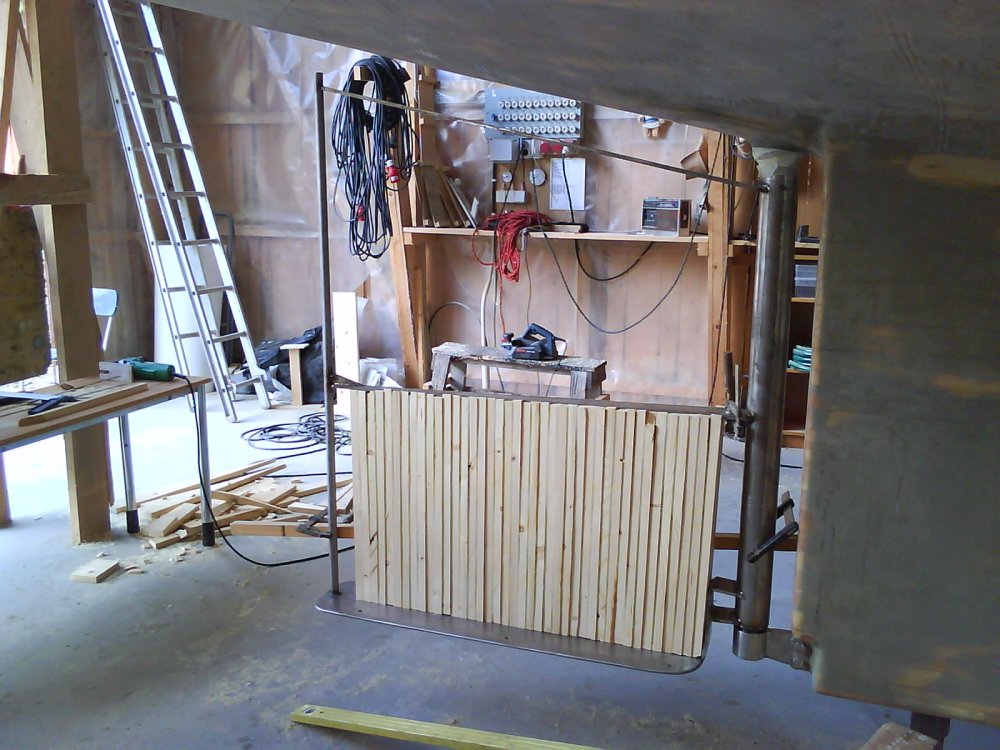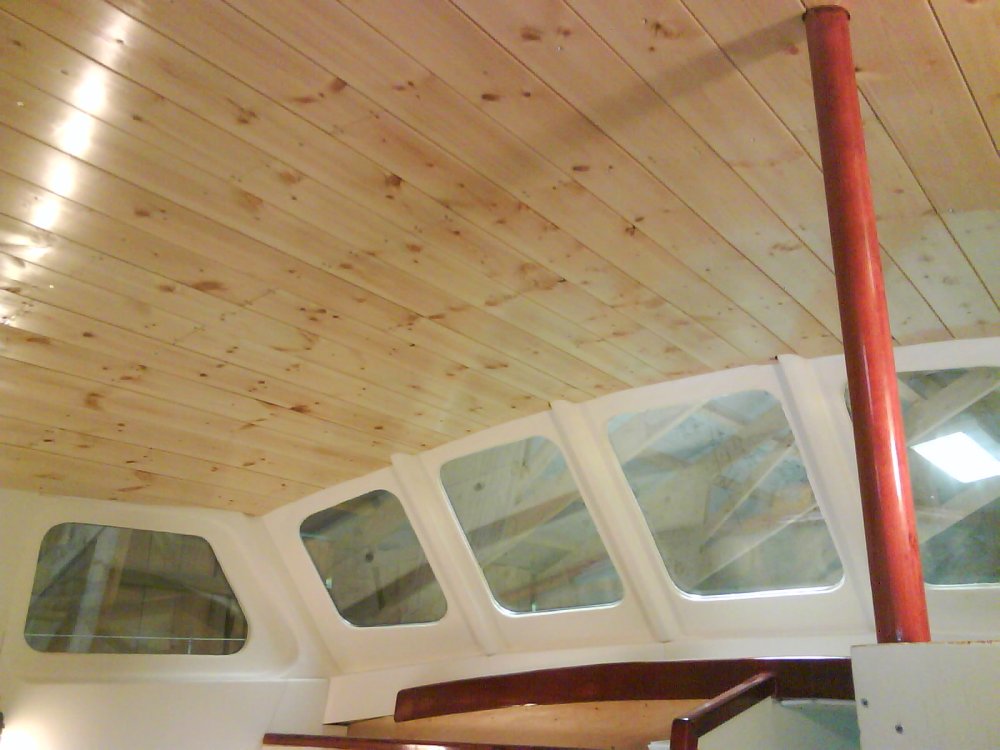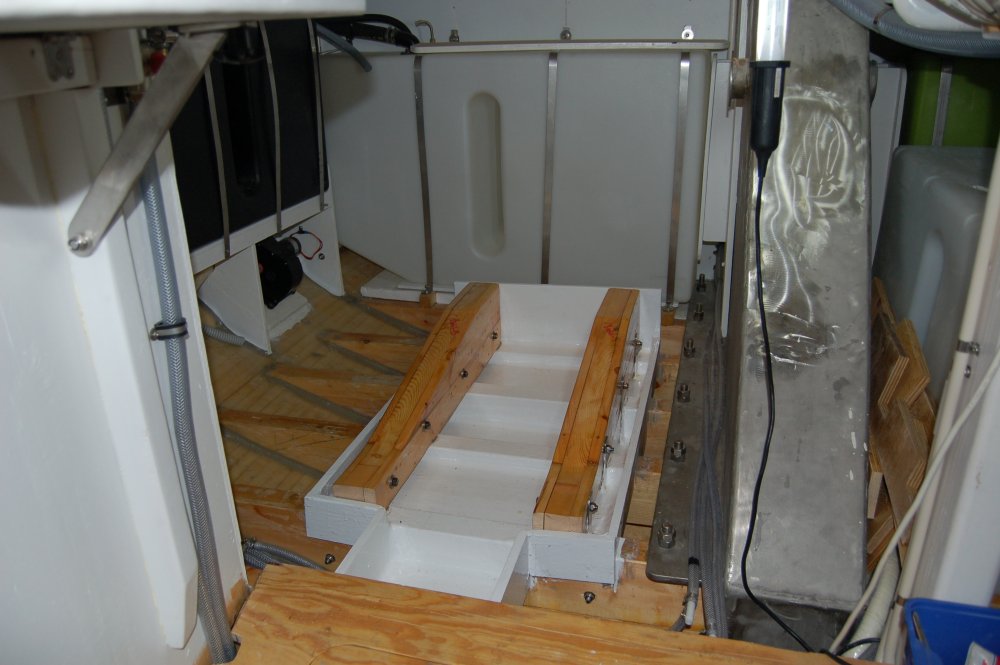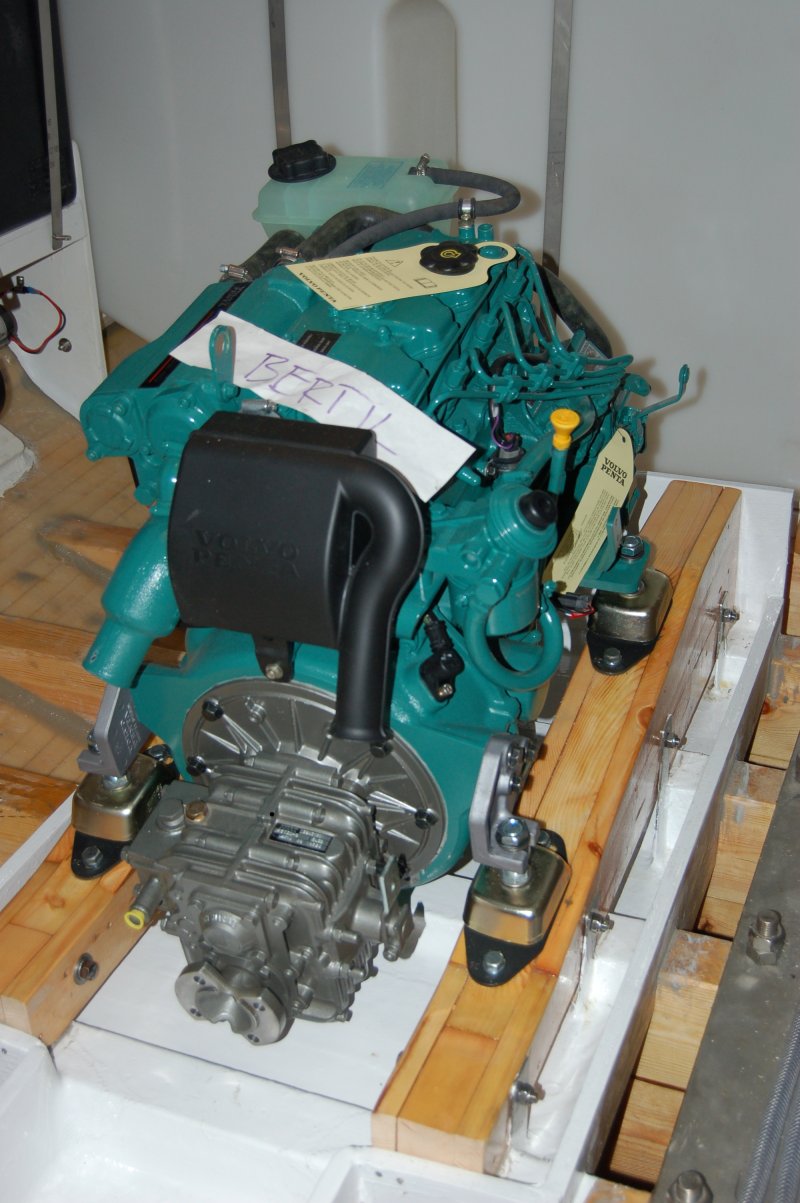
 2008
2008


The engines
by Johan Kjellander 2008, 2014
January to March
The hydraulic steering system is now filled with oil and operational. It's a rather complex system with many components andfittings and has taken quite a lot of time to finish. To the left is a picture from the outside steering position with the wheel mounted on the BCS pump. The controls (Morse S3) for the two motors are also mounted. The deck fitting to the left of the motor control covers the oil filling cap of the pump. To the right is a picture from the inside.
The oil goes from the pump to a bypass and non return valve and further down where it connects with the electric pump for the autopilot system. After that the oil continues aft to the steering cylinder. The thin transparent hoses are temporarily mounted to take care of excess oil during bleeding. Close to the cylinder there is also a cross relief valve set to 78 bar.
The galley is almost finished. The sink is Labradorite stone with a stainless metal bowl and the wall behind covered with sandstone tiles. The Labradorite is a beautiful material, very hard and full of sparkling life. It's difficult to catch on photo but here's a closeup anyway.
Most of the ceilings are now finished. Covered with PVC film and fastened with stainless screws and washers. This picture shows the ceiling forward of the galley.
I also have two pictures from a Roberts 53 built in steel not far from here. The owner has used a technique to get a round and nice shape of the hull that I have not seen before. It reminds of the Radius chine method but each of the metal sheet parts are twisted and welded in a diagonal pattern along the chine. The left picture shows the boat in full size and the right picture is a close up that shows the diagonal welding joints connecting the twisted sheets along the shine.
The story of Bird of Passage is close to the end now. For more than 10 years the project has dominated everyday life for all members of our family. Now it's probably only a year left ! It's difficult to imagine how this will change things but life will surely be different. Last major job is the construction of the retractabe ballast keel. This job will start in a few months. Next winter I hope to be able to mount the motors and next spring she will be moved to Örebro harbor. A trip of 30 km's. Summer 2009 could then be used for testing all systems and changing or replacing things that don't work as planned. After that she is ready for the big trip !
April to June
The last part of the steering system is the rudder blade. It's a big rudder (1.2 x 1.2 m) but not very deep because of the shallow draft of 1.5 meters with the keel up. A stainless frame is welded to the rudder stock and filled with wood. Everything will later be covered with glassfiber and epoxi. Note the stainless steel endplate at the bottom of the rudder. It will increase the efficiency of the rudder and also make it possible to bolt an extra rudder blade onto the bottom of the rudder to make it deeper during ocean passages if it should show to be nessecary. Here is a picture of the lower rudder bearing which is fastened with two M16 screws.
The interior part of the steering system is all finished. Here are two pictures of the rudder arm and cylinder. The little black arm to the left is a rudder angle sensor which is connected to the autopilot system. The system is designed for a rudder torque of 3500 Nm. With a rudder arm length of 260 mm this means that the force acting on the arm from the hydrualic cylinder is 1.35 tons ! To produce this force with a relatively small steering wheel you need to turn the wheel 12 turns to go from full starboard to full port. Also, the hydraulic system automatically locks the rudder in it's current position as soon as you let go of the steering wheel. The plan however, is to let the autopilot do most of the steering. My experience from previous boats is that the autopilot can steer more than 90% of the time.
The entrance doors to the deckhouse are finished and mounted. They are made from two pieces of plywood each with 10 mm of heat insulation between and oak frames. The outside is covered with a pattern of wood from juniper.
The last ceiling to cover was the ceiling of the deckhouse. Instead of white PVC i decided to use wood for this ceiling. I bought cheap pine boards and coated them with two layers of varnish. In order to make it possible to remove an individual board at a later time i cut away the backside of the groove on each board and then fastened them with a large number of stainless screws.
The 11 windows of the deckhouse will have outside frames of stainless steel. I used the CAD files I made for the windows last summer as a template to make the corresponding CAD files for the frames. I then e-mailed the new files to a company with a laser cutter and 2 days later I could pick up 11 perfect frames from nice quality 3 mm thick stainless steel. The outside edges of the frames need grinding to become gentle. The laser cut produces very sharp edges. Then the holes were drilled and finally countersinked. Countersinked screw heads usually have an angle of 90 degrees so I bought a 90 degree countersink tool for metal and it did the job wonderfully. Here is a picture of one of the smaller frames. Job to do is polishing and mounting with sealing compound.
As soon as the rudder blade is finished the rudder will be removed in order to make it possible to fit the boat on it's transport wagon. In this way it is possible to make the distance between the wheel shafts 1.2 meter shorter which is important in order to be able to take the sharp street corners on the road down to the harbor. The rudder will be transported to the harbour separately and mounted after the boat is removed from it's wagon. With the rudder removed the boat will be raised slightly and the wagon pushed in under her. To make this possible the rear wheels (and shaft) will be removed. When the frame of the wagon is in it's right position the rear wheels will be mounted again and the boat lowered to rest on the wagon. I hope this job to be finished within a month or two.
Finally, some remarks on the development of camera technology. When this boat construction blog started the word blog did not exist (I think) and I was still using a traditional (not digital) camera. Each film had to be sent for development and I then scanned the films in a HP Photosmart scanner. Check this picture from 1997 for example, its 600 x 400 pixels and scanned from positive film.
I don't remember exactly when I bought my first digital camera but it was a 2 Mpix Samsung. This picture from 2003 was taken with that camera. The resolution has now increased to 800 x 600.
After some years with the Samsung camera my wife Tove bought a Nikon D50. With this camera I can come closer and view more but the camera is bigger and not always there when you need it. This picture is taken with the Nikon D50 and the resolution is 900 x 568.
Today, I used the 2Mpix. camera in my Sony-Ericsson Z770i mobile telephone to take the photos in this section and I have now increased the resolution to 1000 x 750 pixels.
During the 10 years of this blog the quality of the images has steadily increased and at the same time the cost for taking a picture has decreased to zero ! It's too bad that this development is not universal. How about beer for example, that did not cost anything with smaller bottles that contained more and tasted much better ?
July to September
The rudder is now almost finished. Only thing missing is 4 layers of glass fiber and epoxy and that will be done during this winter. Window frames are also finished and mounted.
A big job this summer has been the boat wagon. A first test showed that the job I did last summer on the wagon was not enough. Bird of Passage is high, 4.35 meters to be exact and the clearance under bridges is only 4.5. This means that the boat needs to be pretty low on the wagon to pass under. To make that possible I had to lower the frame of the wagon some 25 centimeters.
With Bird of Passage on the wagon it became necessary to also roll her out into the free. This was a big moment, finally, after almost 10 years, we would be able to see what she looked like. I was not disappointed. Here is a picture a little from above and here is a picture taken from a lower position.
Sky lights have been mounted. I ordered three Lewmar Ocean hatches and got two ! The last one will come in December ! I wonder what they are doing at the Lewmar factory ? Anyway, Lewmar Ocean hatches are really nice pieces of hardware. Expensive but strong and reliable.
There has also been time to do some job inside. All cabins now have 12 V electric lights. I have spent a lot of time to investigate the possibility of using LED lights but it's still not time to turn to LED 100 % as I see it. Never the less I have installed LED spotlights in the galley. As spot lights, they work well. This picture shows the 5 LED spot lights in the galley. They use only 0.5 Watt each !
I have also installed an Ethernet network. Each cabin has a RJ45 connector where you can plug in a computer and get access to the network. At the moment I have a long cable from my house out to the boat for Internet access. This is what it looks like in the aft cabin right now. I have my computer running, the heat system is on and I have a bed as well. Sleeping in the boat is nice.
A friend of mine is building a Roberts Spray 36 in steel. This summer he built himself a boat house and the boat is now inside and safe. He redesigned the stern a little, tilted it backwards to make more space on the deck, and the boat is now 39 feet.
The last picture this time is from a funeral. My first battery driven screw driver, a Bosch from 1999, died today. It has been used for most of the jobs on the boat during all these years, it has been broken into two pieces (fell down on the concrete floor) and it has been totally covered with epoxy many times. Still it has always done the job and the battery is till fresh. The motor however is now dead. Here is a last picture of a machine that is really a hero !!!
October to December
Main issue this period has been the engines. First problem was that we didn't have any ! I have spent a lot of time during the last years to check prices and technical specifications and as far as I could see the Volvo Penta D2-40 had the best specs but also the highest price. After a lot of detective work I finally found a company in Stockholm with two D2-40's that had been unpacked and exposed in the shop for some time but never started, and to a very good price. The week before christmas we took our Renault Kangoo and went to Stockholm to get them. Here is one of them on its transportation pallet. We soon recognized that if you have two motors you need to call them by different names. Tove decided that we call them Sixten and Bertil. S for starboard (styrbord in Swedish language) and B for port (babord in Swedish language). The motor on the picture is Sixten.
Knowing what motors to fit we could now prepare motor beds in the machine room. A sealed bottom under the motor to keep leaking fluids from spreading into the boat and two well sized wooden beds with 10 degrees of inclination to position the motor in the right angle for the propeller shaft.
Getting the engines in position was relatively easy. Bertil was first and my old tractor managed to lift him high enough to be able to slide him onto the aft deck. A simple lifting gear, me and 3 strong teenagers and we could move Bertil to the entrance door opening. Down the stairs I let him slide on two wooden planks.
Then a new lift and down into the engine room. Here is an overview and a close up.
On this picture you see 175 kg Bertil securley fastened on his bed. A week from now I suppose that Sixten will be making Bertil company on the other side of the keel box.










































